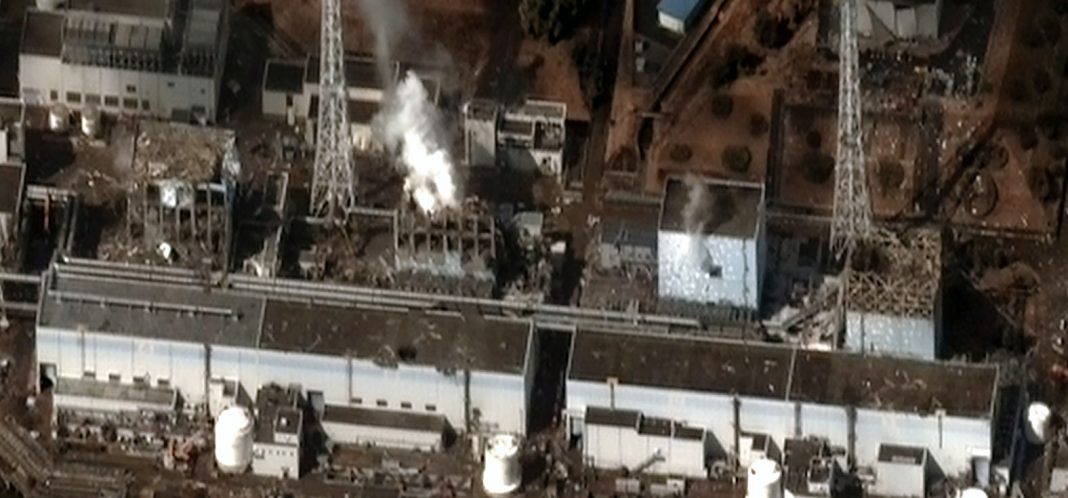On April 11, 2018, I visited the Fukushima Dai-ichi site, thanks to Japan Atomic Industrial Forum (JAIF) and Tokyo Electric Power Company (TEPCO). This Commentary is a collection of my impressions.
The visit
I was in Japan the week of 9 April to speak at the 51st Annual JAIF Conference. The day after the JAIF Conference, I joined a small group, including Ben Heard of Bright New World, for a tour of the Fukushima Dai-ichi site.
Cherry blossoms were mostly gone in Tokyo, but we saw more of them as we traveled north to Fukushima. We stopped for a break at Yotsukura, south of Fukushima. In the roadside facility, we saw a display of the real-time radiation levels at nine monitor points along the highway that runs south and north and inland of Fukushima. The display should give comfort to those driving up the highway that there is no danger from radiation.
I saw a lot of new buildings and facilities that were built to replace tsunami damage. Some towns that were initially evacuated have been released and people have returned.
Our bus passed by the entrance to J-Village, the soccer training center that had been a transition point and staging area for those entering the Fukushima area. The area between J-Village and the Fukushima Dai-ichi site has largely been released from evacuation and J-Village is being returned to its main purpose as a soccer training facility. J-Village will be the training center for the Japanese teams participating in the 2020 Olympics.
Our bus trip terminated at Tomioka. Tomioka is on the coast, about six miles south of the Fukushima Dai-ichi site and a little more than a mile north of the Fukushima Dai-ni site. We heard that Tomioka was where a lot of workers at the two Fukushima nuclear power plants lived. We had lunch at the Tomioka Hotel, a new facility adjacent to the newly re-opened Tomioka train station. In Tomioka, we saw houses, stores, and schools. The photo at the top of this Commentary is a banner that was posted on a small store at the train station.
We took a smaller bus to the Fukushima Dai-ichi site. This was my first visit to the site, but I understand that several things have changed in the past year or so.
Near the site entrance, there were areas that were still evacuated, but the road was open and there were no special precautions in place for travel to the site.
The entrance to the site is through a large new building, with offices, food vendors, and other facilities. There are several thousand people working on the site, a mix of TEPCO employees and contractors, that pass through this facility each day.
We saw the new driverless electric buses that went into service shortly after our visit.
The site has tightly controlled access and monitoring, with body scans going in and going out. We were each issued a dosimeter with a visible reading prior to the site tour. Access to the site no longer requires an anti-contamination suite. Aside from some parts of the site, workers are able to enter the site and do their jobs with no special clothing.
Key Observations
- The emergency diesel generator near units 5 & 6. This emergency generator was the only one that operated after the tsunami.
- FD units 5 and 6, which were not damaged in the earthquake and tsunami, are being used to test robots and other techniques used to examine the first four units.
- A lot of water tanks and several large water treatment facilities were on the site. We understand that much of this water is clean, except low levels of tritium (super heavy water). There were fewer water tanks on the site than I expected.
- There is a dry cask storage area for storage of spent fuel assemblies.
- The cement pump trucks that were used in the initial days to ensure that the spent fuel pools were not dry are still on site. The two pump trucks, a red one made in China and a green one made in Germany, are parked near the entrance, in a place of pride.
- We saw the cooling systems and the pipes used to create the now-complete underground ice wall surrounding unit 1-4 that has stopped much of the ground water flow.
The site has made a lot of progress, with a focus on specific projects at the reactor units and nuclear power plants and the greater site cleanup.
Edward Kee is the CEO and principal consultant at Nuclear Economics Consulting Group (NECG) and an Affiliated Expert at NERA Economic Consulting. In the past he has held senior consulting positions at NERA Economic Consulting, CRA International, PA Consulting Group, Putnam, Hayes & Bartlett, and McKinsey & Company. Prior to becoming a consultant, Kee was a merchant power plant developer and a nuclear power plant engineer (having qualified as chief engineering officer on Nimitz-class nuclear aircraft carriers). He holds an MBA from Harvard University and a BS in Systems Engineering from the US Naval Academy.
Feature Image Source: Wikimedia Commons
© Delhi Defence Review. Reproducing this content in full without permission is prohibited.
































